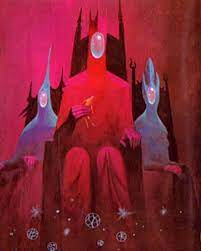Distant Vurania is cloaked in impenetrable clouds, but is known from two recorded Terran expeditions to have a surface capable of supporting human life, at least for a time. It is warmed by volcanism and radioactive elements, and is aided in retaining the heat these produce by it's thick clouds. The light from these sources plays luridly in the gray-green fog, but only partially relieves the darkness. No light from the sun or stars penetrates the gloom, and indeed the atmosphere is opaque to sound and electromagnetic waves in a fairly sort distance. Vurania holds on to its secrets.
There is little life beyond the level of arthropods apparent on the surface of Vurania, though there is evidence that intelligent life once resided there in the form of crumbling monumental structures believed to be temple complexes. Some are decorated with images known from subterranean Precursor ruins on New Terra associated with the worship of the "Spider Goddess." The prevailing theory is that these were built by Precursor dissidents who fled to Vurania following a war, but why Vurania ought of all the worlds in the System is unknown. Scholars who disagree with this theory point to the lack of any apparent buildings beyond the temples in the (admittedly limited) explored areas of the planet, and suggest this was a religious site, and possibly the source of the Spider Goddess cult.
Vurania might be a tempting haven for interplanetary outlaws, but its environmental conditions and distance are factors against it. The everpresent fog has probably contributed to the frequent old spacers' yarns that paint it as a haunted world, a sort of purgatory where crews unlucky enough to stop there may be held forever by the ghosts of their own misdeeds.




































